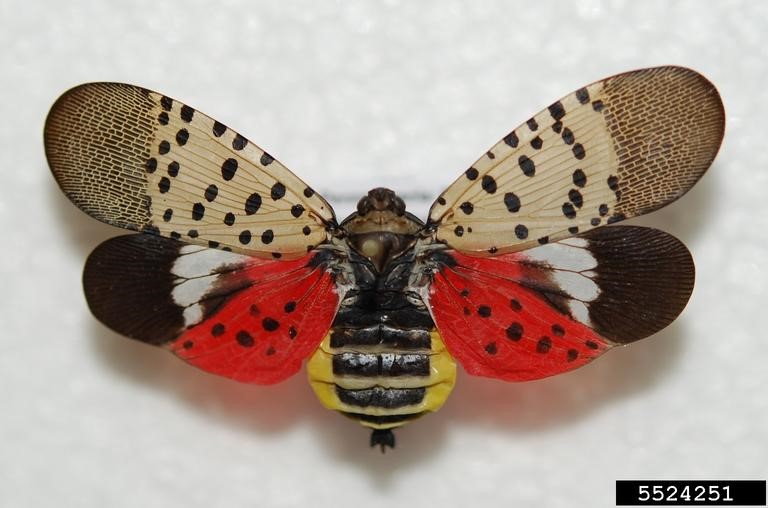Spotted
Lanternfly, an invasive pest targeting plants and trees, detected for first second time in RI
UPDATE: DEM has announced the second sighting of the invasive spotted lanternfly, almost one year after the invasive species was first detected in Rhode Island.
Progressive Charlestown's reporting on the first sighting is below. This new sighting was in Smithfield.
This beautiful bug is bad news because of its potential to wipe out trees, crops and other plant life.
The state’s second spotted lanternfly sighting was reported in Smithfield, according to the DEM, though it’s unclear where exactly in the town the bug was found.
As WPRI reports:
The spotted lanternfly’s eggs typically latch onto trees, but can also be found on picnic tables, wooden pallets and firewood.
Anyone who believes they’ve spotted the invasive species should report it to the DEM immediately."
A single SLF was found in an industrial/commercial area in Warwick near Jefferson Blvd. and a photo of the insect was sent to DEM through its online agricultural pest alert system. DEM's Division of Agriculture confirmed the sighting on August 2 and is asking the public to report any suspected sightings at www.dem.ri.gov/spottedlanternfly.
No known population of SLF is currently
present in this area. DEM will be conducting an extensive survey of the area
based on US Department of Agriculture (USDA) recommendations to determine if
there is any further presence of the invasive insect and will be providing
outreach materials to businesses in the area.
As you can see from these articles, this invasive pest has been expected for several years. Earlier articles on the spotted lanternfly in Progressive Charlestown:
2019: http://www.progressive-charlestown.com/2019/10/rhode-island-on-alert-for-another.html
2020: http://www.progressive-charlestown.com/2020/10/bolo-out-for-invasive-critter.html
2021: http://www.progressive-charlestown.com/2021/06/bolo-alert-out-for-new-invader.html
2021: http://www.progressive-charlestown.com/2021/02/new-alien-invader-threatens-rhode-island.html
2021: http://www.progressive-charlestown.com/2021/08/a-new-pest-is-on-way.html
"In Rhode Island, more than 800 acres of agricultural lands including vineyards, orchards and berry farms are at risk of being infested with SLF, so it's critical that we take the necessary steps to detect and stop the spread of this invasive pest, particularly since it has now been found in our state," said Cynthia Kwolek, senior environmental planner and RI CAPS state survey coordinator in DEM's Division of Agriculture.
DEM,
in partnership with the University of Rhode Island (URI) conducted a statewide
survey in 2019 of local vineyards and areas with large populations of
"Tree of Heaven" plants for SLF. Earlier this year and also in 2020,
DEM and URI held a series of public workshops to help municipalities, the
grower industry, and residents prepare for and respond to this invasive pest,
should it be detected in the state.
In
addition to its spotted patterning, the adult SLF's unique colors feature
scarlet underwings, yellow markings on the abdomen, and tan semi-transparent
forewings. Adult lanternflies are about an inch long and are active from August
until the first hard freeze, which typically occurs from late October into
November.
Although
SLF can fly distances on its own, these pests are excellent hitch hikers and mainly
spread through human movement. Their inconspicuous egg masses can be laid on
pallets, vehicles and other goods, so it is important to inspect shipping
materials and adhere to travel restrictions when moving through areas that are
under quarantine for SLF. The following tips can help stop the spread of SLF:
•
Inspect firewood, vehicles, outdoor furniture, and camping gear for egg masses,
nymphs, and adults. • If you visit states with SLF, check all your gear and
equipment before leaving and scrape off any egg masses.
SLF was first detected in Pennsylvania in 2014 and has quickly spread through surrounding states. An invasive plant-hopper that is currently infesting portions of the mid-Atlantic region of the United States,
SLF has established
populations in Pennsylvania, New Jersey, Maryland, Delaware, and Virginia with
individual finds in New York, Connecticut and Massachusetts. In Pennsylvania,
where the pest has been spreading for over six years, there has been
significant yield loss in vineyards and the insect has become a public
nuisance.
To
learn more about SLF, visit DEM's Agricultural Pest Alerts website at:
www.dem.ri.gov/spottedlanternfly or the URI website at:
https://web.uri.edu/biocontrol/spotted-lanternfly/
To
report a potential finding, please visit:
www.dem.ri.gov/reportspottedlanternfly
For
more information on DEM programs and initiatives, visit http://www.dem.ri.gov/.
Follow us on Facebook at www.facebook.com/RhodeIslandDEM or on Twitter
(@RhodeIslandDEM) for timely updates.
Related
links
Report Sighting
of Spotted Lanternfly
